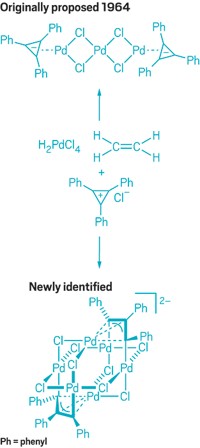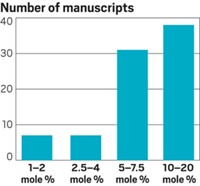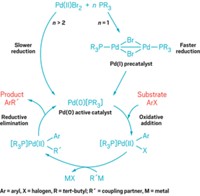Advertisement
Grab your lab coat. Let's get started
Welcome!
Welcome!
Create an account below to get 6 C&EN articles per month, receive newsletters and more - all free.
It seems this is your first time logging in online. Please enter the following information to continue.
As an ACS member you automatically get access to this site. All we need is few more details to create your reading experience.
Not you? Sign in with a different account.
Not you? Sign in with a different account.
ERROR 1
ERROR 1
ERROR 2
ERROR 2
ERROR 2
ERROR 2
ERROR 2
Password and Confirm password must match.
If you have an ACS member number, please enter it here so we can link this account to your membership. (optional)
ERROR 2
ACS values your privacy. By submitting your information, you are gaining access to C&EN and subscribing to our weekly newsletter. We use the information you provide to make your reading experience better, and we will never sell your data to third party members.
Synthesis
ACS Meeting News: Chemists get better acquainted with palladium catalysts
by Stephen Ritter
April 3, 2017

A team of chemists from industry and academia has taken a step back from the normal hustle and bustle of synthesizing new molecules to investigate what happens to workhorse palladium catalysts when they go catalyzing. The traditional thinking has been that a precursor Pd(II) salt is reduced to a catalytically active Pd(0) species when a ligand is introduced. Yet chemists have never had a complete picture of this reduction mechanism, and some scientists have found that under certain conditions a Pd(I) species can get involved in the formation of the Pd(0) active catalyst.
Researchers led by Franziska Schoenebeck, a chemistry professor at RWTH Aachen University, and Thomas J. Colacot, global R&D manager at catalyst firm Johnson Matthey, have now completed a systematic experimental and computational study to better understand how this process really works. Along the way, they found that starting with a Pd(I) bridging dimer precatalyst offers faster reaction rates and better yields than starting with a Pd(II) salt to generate the Pd(0) catalyst, as is commonly done in Buchwald-Hartwig aminations, Suzuki-Miyaura cross-couplings, and other palladium-catalyzed reactions. Colacot presented these new findings on Sunday during a Division of Organic Chemistry symposium at the ACS national meeting in San Francisco.
Although other researchers have previously studied the addition of phosphine ligands to a Pd(II) bromide salt and determined how a bromide-bridging Pd(I) dimer forms, a full accounting of all the molecular participants had been lacking, Colacot said. Schoenebeck, Colacot, and their colleagues determined how the ratio of Pd(II) bromide precursor to phosphine ligand, as well as the order in which the ligand and other reagents are added, dictates whether or not the Pd(I) precatalyst forms ahead of the Pd(0) catalyst. Along the way, the researchers found a key hidden intermediate species, which was visible only when the reactions were run on a gram scale. This new species, a Pd(II)Br3 dimer, turns out to be the linchpin that holds the pathway together for formation of the Pd(I) precatalyst.
Ultimately, the researchers found that starting with the preformed Pd(I) precatalyst provides better results than starting with the Pd(II) bromide salt and adding the phosphine ligand (J. Am. Chem. Soc. 2017, DOI: 10.1021/jacs.7b01110). “This implies that absolute process precision is required in catalysis to get the optimal results,” Colacot said.
Related story: Chemists introduce a user’s guide for palladium acetate
The new findings already have Bruce H. Lipshutz of the University of California, Santa Barbara, and his group thinking about ways to improve their palladium-catalyzed reaction chemistry. The symposium where Colacot made his presentation was in Lipshutz’s honor as the 2017 recipient of the Herbert C. Brown Award for Creative Research in Synthetic Methods.
The Schoenebeck and Colacot report “is a must-read,” Lipshutz said. “It’s an outstanding example of collaboration between academic and industrial groups that creates tremendous value for the catalysis community.”
Colacot said the Pd(I) precatalyst is commercially available and is being sold in kilogram amounts. In addition, other Pd(I) precatalysts based on the new information have been tested by the Schoenebeck group and are becoming available.
More related stories:





Join the conversation
Contact the reporter
Submit a Letter to the Editor for publication
Engage with us on Twitter